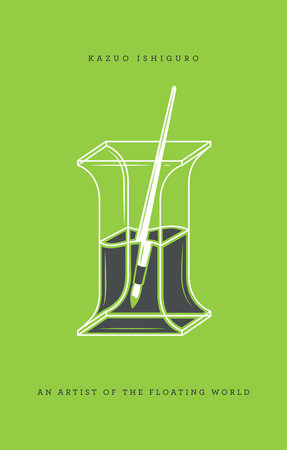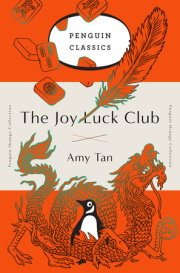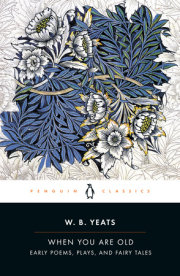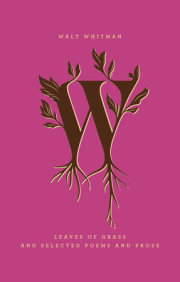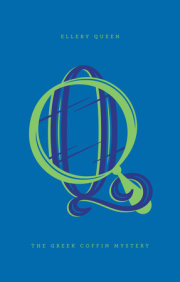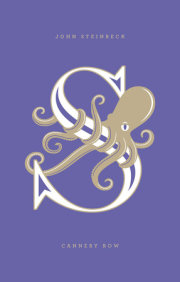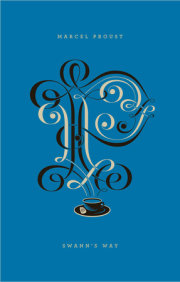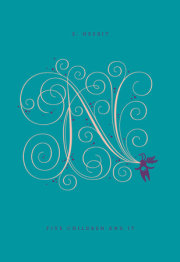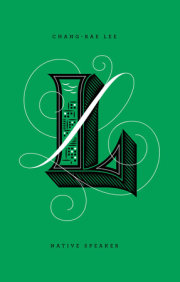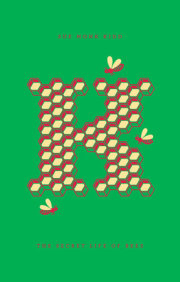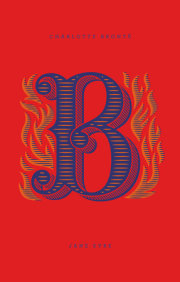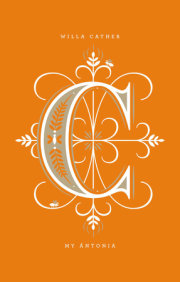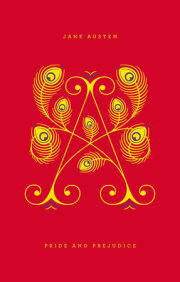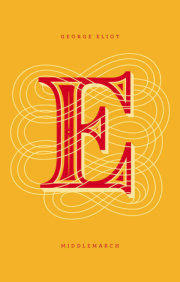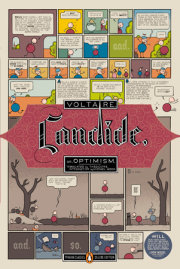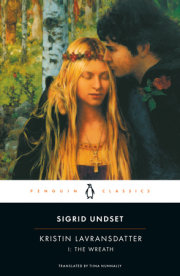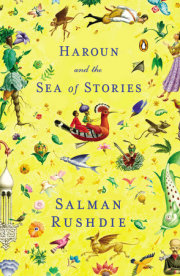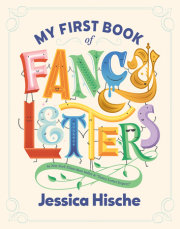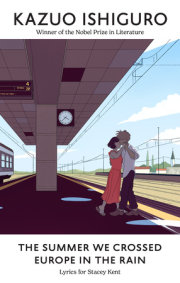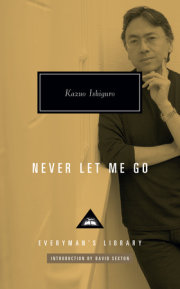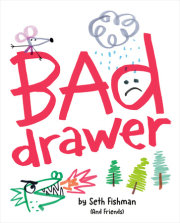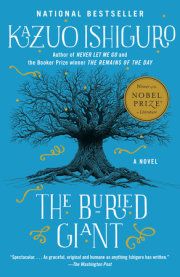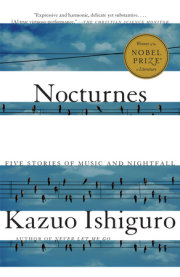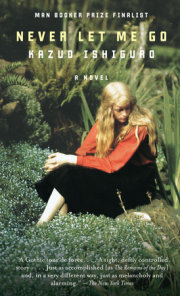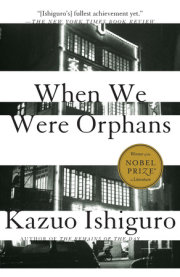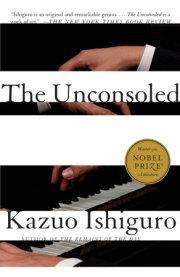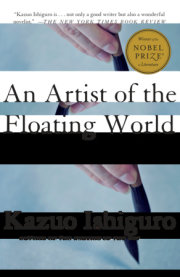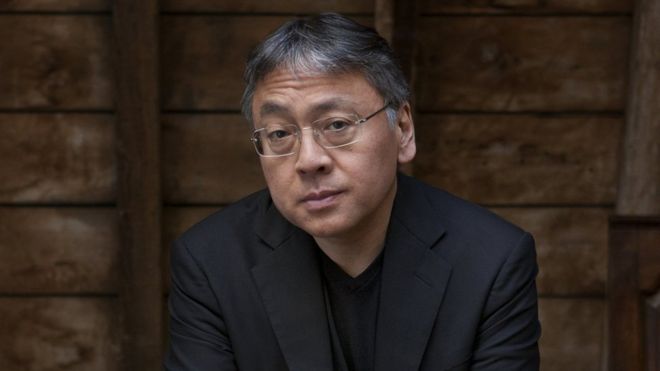If on a sunny day you climb the steep path leading up from the little wooden bridge still referred to around here as ‘the Bridge of Hesitation’, you will not have to walk far before the roof of my house becomes visible between the tops of two gingko trees. Even if it did not occupy such a commanding position on the hill, the house would still stand out from all others nearby, so that as you come up the path, you may find yourself wondering what sort of wealthy man owns it.
But then I am not, nor have I ever been, a wealthy man. The imposing air of the house will be accounted for, perhaps, if I inform you that it was built by my predecessor, and that he was none other than Akira Sugimura. Of course, you may be new to this city, in which case the name of Akira Sugimura may not be familiar to you. But mention it to anyone who lived here before the war and you will learn that for thirty years or so, Sugimura was unquestionably amongst the city’s most respected and influential men.
If I tell you this, and when arriving at the top of the hill you stand and look at the fine cedar gateway, the large area bound by the garden wall, the roof with its elegant tiles and its stylishly carved ridgepole pointing out over the view, you may well wonder how I came to acquire such a property, being as I claim a man of only moderate means. The truth is, I bought the house for a nominal sum—a figure probably not even half the property’s true value at that time. This was made possible owing to a most curious—some may say foolish—procedure instigated by the Sugimura family during the sale.
It is now already a thing of some fifteen years ago. In those days, when my circumstances seemed to improve with each month, my wife had begun to press me to find a new house. With her usual foresight, she had argued the importance of our having a house in keeping with our status—not out of vanity, but for the sake of our children’s marriage prospects. I saw the sense in this, but since Setsuko, our eldest, was still only fourteen or fifteen, I did not go about the matter with any urgency. Nevertheless, for a year or so, whenever I heard of a suitable house for sale, I would remember to make enquiries. It was one of my pupils who first brought it to my attention that Akira Sugimura’s house, a year after his death, was to be sold off. That I should buy such a house seemed absurd, and I put the suggestion down to the exaggerated respect my pupils always had for me. But I made enquiries all the same, and gained an unexpected response.
I received a visit one afternoon from two haughty, grey-haired ladies, who turned out to be the daughters of Akira Sugimura. When I expressed my surprise at receiving such personal attention from a family of such distinction, the elder of the sisters told me coldly that they had not come simply out of courtesy. Over the previous months, a fair number of enquiries had been received for their late father’s house, but the family had in the end decided to refuse all but four of the applications. These four applicants had been selected carefully by family members on grounds purely of good character and achievement.
‘It is of the first importance to us’, she went on, ‘that the house our father built should pass to one he would have approved of and deemed worthy of it. Of course, circumstances oblige us to consider the financial aspect, but this is strictly secondary. We have therefore set a price.’
At this point, the younger sister, who had barely spoken, presented me with an envelope, and they watched me sternly as I opened it. Inside was a single sheet of paper, blank but for a figure written elegantly with an ink brush. I was about to express my astonishment at the low price, but then saw from the faces before me that further discussion of finances would be considered distasteful. The elder sister said simply: ‘It will not be in the interests of any of you to try to outbid one another. We are not interested in receiving anything beyond the quoted price. What we mean to do from here on is to conduct an auction of prestige.’
They had come in person, she explained, to ask formally on behalf of the Sugimura family that I submit myself—along, of course, with the other three applicants—to a closer investigation of my background and credentials. A suitable buyer could thus be chosen.
It was an eccentric procedure, but I saw nothing objectionable about it; it was, after all, much the same as being involved in a marriage negotiation. Indeed, I felt somewhat flattered to be considered by this old and hidebound family as a worthy candidate. When I gave my consent to the investigation, and expressed my gratitude to them, the younger sister addressed me for the first time, saying: ‘Our father was a cultured man, Mr Ono. He had much respect for artists. Indeed, he knew of your work.’
In the days which followed, I made enquiries of my own, and discovered the truth of the younger sister’s words; Akira Sugimura had indeed been something of an art enthusiast who on numerous occasions had supported exhibitions with his money. I also came across certain interesting rumours: a significant section of the Sugimura family, it seemed, had been against selling the house at all, and there had been some bitter arguments. In the end, financial pressures meant a sale was inevitable, and the odd procedures around the transaction represented the compromise reached with those who had not wished the house to pass out of the family. That there was something high-handed about these arrangements there was no denying; but for my part, I was prepared to sympathize with the sentiments of a family with such a distinguished history. My wife, however, did not take kindly to the idea of an investigation.
‘Who do they think they are?’ she protested. ‘We should tell them we want nothing further to do with them.
‘But where’s the harm?’ I pointed out. ‘We have nothing we wouldn’t want them to discover. True, I don’t have a wealthy background, but no doubt the Sugimuras know that already, and they still think us worthy candidates. Let them investigate, they can only find things that will be to our advantage.’ And I made a point of adding: In any case, they’re doing no more than they would if we were negotiating a marriage with them. We’ll have to get used to this sort of thing.’
Besides, there was surely much to admire in the idea of ‘an auction of prestige’, as the elder daughter called it. One wonders why things are not settled more often by such means. How so much more honourable is such a contest, in which one’s moral conduct and achievement are brought as witnesses rather than the size of one’s purse. I can still recall the deep satisfaction I felt when I learnt the Sugimuras—after the most thorough investigation—had deemed me the most worthy of the house they so prized. And certainly, the house is one worth having suffered a few inconveniences for; despite its impressive and imposing exterior, it is inside a place of soft, natural woods selected for the beauty of their grains, and all of us who lived in it came to find it most conducive to relaxation and calm.
For all that, the Sugimuras’ high-handedness was apparent everywhere during the transactions, some family members making no attempts to hide their hostility towards us, and a less understanding buyer might well have taken offence and abandoned the whole matter. Even in later years I would sometimes encounter by chance some member of the family who, instead of exchanging the usual kind of polite talk, would stand there in the street interrogating me as to the state of the house and any alterations I had made.
These days, I hardly ever hear of the Sugimuras. I did, though, receive a visit shortly after the surrender from the younger of the two sisters who had approached me at the time of the sale. The war years had turned her into a thin, ailing old woman. In the way characteristic of the family, she made scant effort to hide the fact that her concern lay with how the house—rather than its inhabitants—had fared during the war; she gave only the briefest of commiserations on hearing about my wife and about Kenji, before embarking on questions concerning the bomb damage. This made me bitter towards her at first; but then I began to notice how her eyes would roam involuntarily around the room, and how she would occasionally pause abruptly in the midst of one of her measured and formal sentences, and I realized she was experiencing waves of emotion at finding herself back in this house once more. Then, when I surmised that most of her family members from the time of the sale were now dead, I began to feel pity for her and offered to show her around.
The house had received its share of the war damage. Akira Sugimura had built an eastern wing to the house, comprising three large rooms, connected to the main body of the house by a long corridor running down one side of the garden. This corridor was so extravagant in its length that some people have suggested Sugimura built it—together with the east wing—for his parents, whom he wished to keep at a distance. The corridor was, in any case, one of the most appealing features of the house; in the afternoon, its entire length would be crossed by the lights and shades of the foliage outside, so that one felt one was walking through a garden tunnel. The bulk of the bomb damage had been to this section of the house, and as we surveyed it from the garden I could see Miss Sugimura was close to tears. By this point, I had lost all my earlier sense of irritation with the old woman and I reassured her as best I could that the damage would be repaired at the first opportunity, and the house would be once more as her father had built it.
I had no idea when I promised her this that supplies would remain so scarce. For a long time after the surrender one could wait weeks just for a particular piece of wood or a supply of nails. What work I could do under such circumstances had to be done to the main body of the house—which had by no means entirely escaped damage—and progress on the garden corridor and the east wing has been slow. I have done what I can to prevent any serious deterioration, but we are still far from being able to open that part of the house again. Besides, now with only Noriko and myself left here, there seems less urgency to be extending our living space.
Copyright © 1989 by Kazuo Ishiguro. All rights reserved. No part of this excerpt may be reproduced or reprinted without permission in writing from the publisher.





